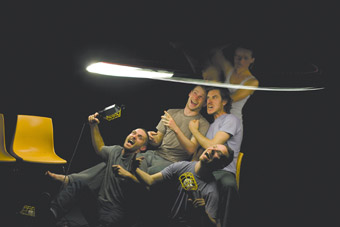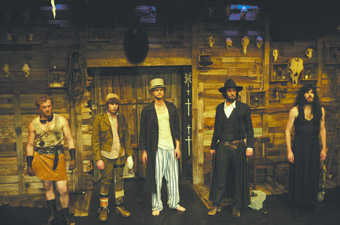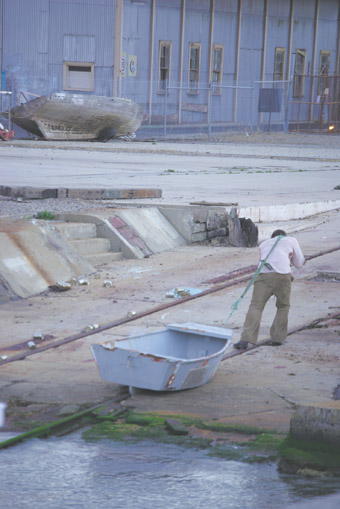reveries and dark dreams beyond categories
john bailey: perry & hamilton, the black lung, red cabbage

Byron Perry, Antony Hamilton, Lee Serle, Stephanie Lake, I Like This, Chunky Move
photo Genevieve Bailey
Byron Perry, Antony Hamilton, Lee Serle, Stephanie Lake, I Like This, Chunky Move
THE VARIOUS LABELS WE USE TO CATEGORISE THE CAREER DEVELOPMENT OF ARTISTS—EMERGING, PRO-AM, MID-CAREER, FRINGE, PROFESSIONAL—ALWAYS HANG UNEASILY UPON THEIR SHOULDERS, LIKE A RENTAL TUX THAT’S BEEN THROUGH THE WASH ONE TOO MANY TIMES. THEY’RE USUALLY EMPLOYED TO POSITION SOMEONE WITHIN A LARGER ‘INDUSTRY’, BUT THE AMORPHOUS NATURE OF THE ARTS, ALONG WITH FICKLE FUNDING, THE DIFFICULTY IN DEFINING A ‘MAINSTREAM’ AND THE WONDERFUL CROSS-DISCIPLINARY ACTIVITIES WHICH MAKE UP SO MUCH OF OUR CREATIVE LANDSCAPE CONTRADICT SUCH PIGEONHOLING. THREE PRODUCTIONS WHICH APPEARED AT THE TAIL-END OF 2008 ARE CASES IN POINT.
Byron Perry and Antony Hamilton are amongst the most recognisable contemporary dancers in Melbourne, having featured heavily in the calendars of Chunky Move and Lucy Guerin Inc for several years as well as popping up in the works of younger dancemakers. Their first original collaboration, I Like This, can’t really be classed as the debut of two emerging choreographers. There are two immediately apparent reasons: firstly, both dancers have distinct styles and interests which have been evident in their previous performances for others. Secondly, the influences of these earlier mentors have left particular traces in the witty, astute form of I Like This.
Billed as a choreographic conversation between Hamilton and Perry, the work is partly an exploration of the process of dance-making, in which their ideas of what the work is to become are played out around them by a cadre of talented performers. But while this kind of meta-theatre is hardly ground-breaking—and reached a superb apex in Guerin’s and Chunky Move’s respective contributions to the last Melbourne International Arts Festival (see RT88, p4), both starring Hamilton and Perry—I Like This takes its concepts in pleasing new directions. It’s not a navel-gazing piece of the sort presented in Wendy Houstoun’s Desert Island Dances, another MIAF event. Here, action supercedes analysis.
The duo clearly recorded their rehearsal process and used the result to produce a kind of remixed dance. The performers begin to move, then rewind, skip or become stuck in loops. All the while, Perry and Hamilton sit surrounded by lighting panels, power boards and snaking cables, orchestrating the handheld lamps carried by the dancers. In fact, Perry and Hamilton’s visual design for the work deserves particular mention, becoming a character almost in itself, with hundreds of perfectly executed changes whose sometimes stroboscopic effect makes lighting operation appear a form of choreography in its own right.
It’s self-reflexive dance, certainly, but by incorporating technology in such a sophisticated way it becomes something much more. And when the work ends with the two choreographers covered by a giant quilted doona, lights sparking underneath like flashes on a distant mountain range, the result approaches the sublime. Emerging artists? Far from it.

Avast, Black Lung
photo Jeff Busby
Avast, Black Lung
The Black Lung are another ensemble well entrenched in Melbourne’s independent arts scene while occupying an utterly, defiantly outsider space. But, testament to the inadequacy of such categories, they were picked up by the Malthouse for a residency in its Tower program.
The Tower season consisted of a remounting of Avast, first produced three years ago, and a new work entitled Avast II: The Welshman Cometh. The theatre itself was radically transformed during the three month residency, outfitted with dingy couches, graffiti-covered walls and a massive wooden set filled with animal skulls, worn leather, animated dummies and dusty ephemera. Both productions were equally ramshackle, eclectic and brilliantly detailed.
The Black Lung create the kind of anarchy that can only result from incredible precision, an effect most notably associated with Forced Entertainment. During Avast, a confrontation between two brothers haunted by a legacy of familial murder and betrayal is interrupted by a falling spotlight which crashes to the ground inches from the actors’ feet. They are visibly shaken as they attempt to continue the scene, and convincing the audience that this wasn’t a pre-planned moment only proves the astounding capabilities of these performers. Similarly, the constant sense of competition, potential violence and despair of the actors themselves creates a brilliant blurring of understanding—are we watching something taking place, or something failing to take place?
Underneath the deliberate chaos is a thick questioning of theatre, narrative convention and masculinity. The two works are almost entirely composed of pastiche, quotations from film, literature and generic devices overlapping constantly. It’s all brutally blokeish too, with the only female character killed in the opening moments of Avast (unless you count another male character’s inexplicable change in gender halfway through the second work). And while Avast II is evidently a new work, the three years of development accorded Avast have made it one of the tightest, funniest, scariest pieces of theatre I’ve seen in years.

Collapse, Red Cabbage Collective
photo Matthew Scott–Cheeky Monkey Enterprises
Collapse, Red Cabbage Collective
Melbourne collective Red Cabbage might be the artistic equivalent of the Slow Food movement—like incidental fellow travellers such as Eleventh Hour Theatre, Red Cabbage eschew quantity for quality, creating one work per year. The time commitment was certainly evident in Collapse, an epic, large scale installation and performance located across a remote former maritime precinct in Williamstown. Audiences were transported by a 20-minute boat ride to a post-apocalyptic world both staggering and serene. Disembarking from the vessel, we were met by linen-clad survivors of some disaster dredging canned food from the ocean, hauling rotten row-boats across concrete as the twilight descended; we gathered in a vast, weed-strewn warehouse where women lyrically spoke around the mysterious disaster which had befallen the community; we roamed a maze of sheds, alleyways and ruined sites housing countless traumatised inhabitants coping with the new reality into which they’d been reborn. An alchemist conducted strange experiments in a bubbling lab while a babbling wreck spewed poetry in a nearby shanty. The enigmatic, voyeuristic voyage ended in a gargantuan warehouse-cum-cinema, a ragged corps of drive-in speakers standing to attention before the flickering celluloid images retrieved from a lost world. Gaps in the canvas screen revealed blue skies and drifting clouds, as much a memory as the filmic footage being projected. The survivors gathered before this iconic scene in reverential silence. Minutes later, it was all over.
Collapse’s narrative was piecemeal and its meaning kept obscure, allowing each visitor their own interpretation. The audience was allowed to wander individually; unlike the masterfully subtle control of attention exercised by another interesting company, Peepshow Inc’s similar The Mysteries of the Convent (2008), there were plenty of opportunities to miss a dramatic moment or provocative scene here. Collapse’s effect was a cumulative one, however—even the relatively uneventful prefacing boat ride worked to establish a mood of quiet distance and reflection, producing a sense of reverie.
It’s difficult to stamp any of these three works as “emerging”, though all fit a technical definition. But all are equally the products of artists who have been honing their crafts for years and all exceed journeyman status. The next evolutionary step for each will most likely prove just as hard to classify.
I Like This, choreography, direction, lighting, sound Antony Hamilton, Byron Perry, performers Hamilton, Perry, Stephanie Lake, Alisdair Macindoe, Lee Serle, costumes Paula Levis, Chunky Move Studios, Nov 20-29; Avast and Avast II: The Black Lung Theatre Company, The Welshman Cometh, performers Sacha Bryning, Gareth Davies, Thomas Henning, Mark Winter, Thomas Wright, Dylan Young, sound design, music Liam Barton, lighting design Govin Ruben,Tower Theatre, CUB Malthouse, Nov 12 – Dec 6; Red Cabbage, Collapse, creators Louise Morris, Tania Smith, Kirsten Prins, Anna Hamilton, performers Jason Lehane, Claire Reynolds, Maria Sirpis, Jason Cavanagh, Kate Boston Smith, Alice Claringbold, Ross Farrell, Krista Green, Portia Chiminello, Carlo Marasea; Seaworks, Williamstown, Melbourne, Nov 19-30, 2008
RealTime issue #89 Feb-March 2009 pg. 12






